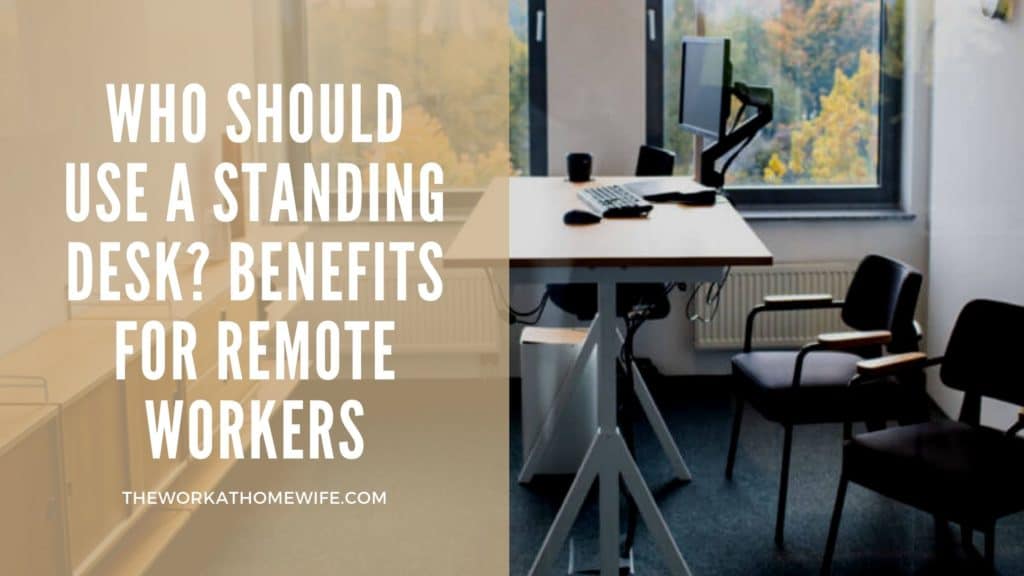Share this
INSIDE: Wondering who should use a standing desk? In this article, you’ll discover the pros and cons of sit-stand desks, how to know if a standing desk is right for you, and what to consider when it comes to purchasing one.
While many people envision remote workers as a more relaxed crowd enjoying morning walks and afternoon naps, the opposite is often quite true. Many telecommuters as workaholics by heart and embrace the ability to both be an early bird and burn the night oil. All of these long hours working can wreak havoc on the body.
We’ve all heard in recent years that a sedentary lifestyle is bad for your health, that includes sitting too much. Some experts consider sitting the new smoking. But in addition to health consequences, you may simply find yourself with an aching back, headaches and fatigue caused by all of that sitting.
That’s why standing desks have become so popular in recent times, even with the work-at-home crowd. Not to mention, they just might increase your productivity.
What exactly is a standing desk?
The device is quite simple. It allows you to stand while working. It provides ergonomic elevation of your computer and keyboard so you can work on your feet as opposed to sitting in a chair.
How that is accomplished varies on the model. Some standing desks are always in a raised position. Others can go up or down with the assistance of counterbalancing, a crank, pneumatic cylinder, springs or electricity.
What are the pros and cons of sit-stand desks?
When working in a traditional office environment, you likely had some movement throughout the day. You probably had scheduled breaks. Perhaps you had to walk over to a coworker’s or your boss’ desk several times over the course of a day. When telecommuting, even these small movements are no longer necessary. Once you get into your groove, you may not move from the same sitting position for hours. That can put a lot of strain on your back and shoulders. Standing while working can alleviate that strain.
That being said, it may not solve all of your problems. If you have poor standing posture or lock your knees while standing, this can cause other sources of pain. There are also tasks like typing that are better done from a seated position. A combination of sitting and standing throughout the day is what many people find the best solution – sit for one hour, stand for 5 to 15 minutes.
These specialized standing workstations can also be expensive and cumbersome to work with. You may want to try out a few models in person before making a big investment. You may also want to have a professional setup to ensure your new desk is ergonomically correct and at the correct desk height.
How can you determine if a standing desk is right for you?
Let’s start by saying, a standing desk is not going to help you lose weight. If calorie burn is your goal, you will need to succumb to physical activity.
If you are experiencing back or neck pain that you believe is associated with long hours in a seated position, you may want to try a standing desk periodically throughout the day. As said previously, however, standing all day can come with its own problems. It’s best to alternative your position throughout the day.
My own standing desk experience
I got my first sit stand desk several years ago. Since then, I’ve put to use two more – one portable laptop desk and a larger version that fit two monitors. As someone with chronic back problems, they have provided a lot of relief. As with most remote workers, I can easily put in a lot of hours depending on the season. I’m not always good about getting up for regular breaks to stretch and walk around. The simple movement from sitting to standing can get blood flowing to my legs and provide some relief from stiffness.
Things to consider when looking into standing desks
Standing desks are not a one-size-fits-all option. There are a lot of things to think about and your desk options can run from inexpensive DIY to several thousand dollars. A few things to consider:
- Pricing
- Stability
- Ease of use
- Ergonomics
You have several options to choose from:
Fixed Frame Desk: A fixed frame desk will always be at standing height. It doesn’t move up and down. This can be an inexpensive DIY option that can be achieved as simply as placing blocks under your existing desk. You will likely still want to sit at some point, however. That can be achieved by purchasing an adjustable drafting chair.
Adjustable Standing Desk: Adjustable height desks can be moved up and down depending on whether you want to sit or stand. These desks can range from very heavy and expensive if they are pneumatic or an electric standing desk. If you choose a lighter, more inexpensive model, make sure you check out the reviews for stability.
Conversion Desk: A standing desk converter is simply an adjustable stand that sits on your existing desk. These can be a more inexpensive option than a full desk though you do need to verify their range of motion and desktop space. As they will likely raise the height of where you sit at your existing desk, you may still need to purchase a drafting chair if your current office chair doesn’t go that high.
Attachments: Attachments are often the cheapest and most flexible option, especially if you love your current desk and home office setup. Swing arms are a popular option and are relatively easy to set up and use. This may be a good option if your preferred computer is a laptop and you participate in a lot of teleconferencing. (Swing arms may not be the best for typing.) If you have several working spaces throughout your house, you may even want to purchase a few.
Remember. A standing desk is not a replacement for physical activity. You are not likely to burn more calories and get in better shape if you use one. You may want to look into a treadmill desk if that is your goal. Instead, you are simply going to enjoy the relief from stiffness and fatigue that can come from changing positions, something that’s not so easy to do when sitting in an office chair.












